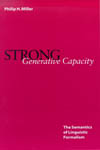
Strong Generative Capacity
The Semantics of Linguistic Formalism
Philip Miller
The concept of “strong generative capacity” (SGC) of a linguistic formalism was introduced by Chomsky in the early sixties in order to characterize descriptive capacity. However, the original definition proposed by Chomsky turned out to be unusable, especially when one wished to compare the SGC of different types of formalisms. This book provides for the first time a rigorous and useful characterization of SGC, defining it as the model theoretic semantics of linguistic formalism. Specifically, abstract interpretation domains are defined in theory-neutral set-theoretical terms, and the SGC of a theory with respect to a given interpretation domain is characterized as the range of a specific interpretation function mapping structural descriptions of that theory into elements of that domain. Interpretation domains are defined for such notions as labeled constituency, dependency, endocentricity and linking and applied to the analysis of a range of linguistic formalisms, among which context-free grammars, dependency grammars, X-bar grammars, tree-adjoining grammars, transformational grammars and categorial grammars.
Philip Miller is a professor of linguistics at the University of Lille and is a member of the SILEX research group of the Centre National de la Recherche Scientifique.
- Preface
- 1 Classical Definitions of Weak and Strong Generative Capacity
- 2 Constituency, Dependency, Labeling and Ordering
- 2.1 Equivelence in SGC in Terms of Isomorphism
- 2.2 Relevant Functions and Relations
- 2.3 Interpretation Domains: the Case of Constituent
- 2.4 Interpretation Functions
- 2.5 Advantages of the Approach
- 2.5.1 Explicitness
- 2.5.2 Alternate Definitions
- 2.5.3 General Applicability
- 2.6 Labeled Constituent Structure
- 2.7 Linear Order
- 2.8 An Interpretation Domaain for Dependency
- 2.9 Simple Dependency Grammars
- 2.10 An Interpretation Function for Dependency for DGs
- 2.11 Ordering properties of DGs
- 2.12 Constituent Structures Expressed by DGs
- 2.13 Independence of Constituency and Dependency Interpretations for DGs
- 2.14 Expressibility of Dependency
- 2.15 Legitimate Interpretation Functions
- 3 Strong Generative Capacity: the Semantics of Linguistic Formalism
- 3.1 SGC of a Grammar G with respect to an Interpretation Domain IDi
- 3.2 SGC of a Theory T with respect to an Interpretation Domain IDi
- 3.3 SGC of a Grammar G with respect to a Tuple of Interpretation Domains 〈ID1, …, IDn〉
- 3.4 SGC of a Theory T with respect to a Tuple of Interpretation Domains 〈ID1, …, IDn〉
- 3.5 Analogy with Model-theoretic Semantics
- 3.6 Comparing Grammars and Theories in SGC
- 3.6.1 Equivalence
- 3.6.2 Inclusion
- 3.7 Interpreting Sets of Sturctural Descriptions vs. Interpreting Grammars: Ordering in ID/LP Grammars vs. Classical CFGs
- 3.8 What is a Structural Description?
- 3.8.1 Structural Descriptions in TAGs
- 3.8.2 The Configurational Definitiion of Grammatical Relations
- 3.9 Conclusion
- 4 Constituency, Dependency, Ordering, and Endocentricity in Phrase Structure Grammars
- 4.1 Phrase Structure Grammars and Dependency
- 4.1.1 Marked Context Free Grammars (MCFGs)
- 4.1.2 Weakly Marked CFGs (WMCFGs)
- 4.1.3 Strongly Marked CFGs (SMCFGs)
- 4.1.4 X-bar Grammars
- 4.2 Discontinuous Constituency in Phrase Structure Grammars
- 4.2.1 Introduction
- 4.2.2 Liberation Grammars
- 4.2.3 Comparing SGC
- 4.3 Endocentricity
- 4.3.1 Expression of Endocentricity in CFGs
- 4.3.2 Expression of Endocentricity in MCFGs
- 4.3.3 Expression of Endocentricity by XBGs
- 4.3.4 A Note on Adjunction and Rule Schemata with Kleene Stars in CFGs
- 5 Aspects of the Strong Generative Capacity of Categorical Grammars
- 5.1 Legitimate Interpretations of Simple Categorical Grammars
- 5.1.1 Simple Categorical Grammars
- 5.1.2 Constituency and Labeling
- 5.1.3 Endocentricity
- 5.1.4 Functor-Argument Structure
- 5.1.5 Dependency
- 5.2 The SGC of Simple Categorial Grammars
- 5.2.1 Constituency
- 5.2.2 Dependency
- 5.2.3 Endocentricity
- 6 Linking Systems
- 6.1 Introduction
- 6.1.1 Constituent Addresses and Node Addresses
- 6.1.2 Empty Constituents
- 6.1.3 Constraints between Linking and Constituency
- 6.1.4 Command Constraints on Links
- 6.2 Linking Systems for Filler-gap Dependencies
- 6.3 Linking Systems for Filler-gap Dependencies in GPSC
- 6.4 Linking Systems for Filler-gap Dependencies in Parenthesis-free CGs
- 6.5 Linking Systems for Filler-gap Dependencies in TGs
- 6.6 Linking Systems without Gaps: LFG and HPSG-3
- 6.7 Linking Systems for Filler-gap Dependencies in EPSGs with Stacks of Slash Features
- 6.7.1 Introduction
- 6.7.2 Indexed Grammers of Type IGa
- 6.7.3 Indexed grammars of Type IGb
- 6.7.4 Indexed grammars of Type IGc
- 6.7.5 Multisets as Values for SLASH Features
- 6.8 Some Further Perspective on Linking Systems
- 7 Conclusion
- References
- Index of Subjects and Abbreviations
- Index of Names
1/1/2000
ISBN (Paperback): 157586214X (9781575862149)
ISBN (Cloth): 1575862131 (9781575862132)
Subject: Linguistics; Generative Grammar; Semantics
|



Distributed by the
University of
Chicago Press
|


